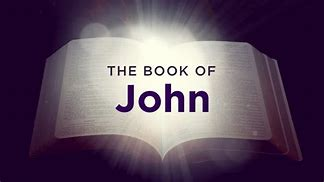The Resurrection - {Interlinear <Greek>}
20:1 - Now {δὲ <de>} on → the {Τῇ <ho>} first {μιᾷ <heis>} day ← of → the {τῶν <ho>} week {σαββάτων <sabbaton>} Mary {Μαρία <Maria>} Magdalene {ἡ Μαγδαληνὴ <ho Magdalēnē>} came {ἔρχεται <erchomai>} to {εἰς <eis>} the {τὸ <ho>} tomb {μνημεῖον <mnēmeion>} early, {πρωῒ <prōi>} while → it → was {οὔσης <eimi>} still {ἔτι <eti>} dark, {σκοτίας <skotia>} and {καὶ <kai>} saw {βλέπει <blepō>} that • the {τὸν <ho>} stone {λίθον <lithos>} had been taken away {ἠρμένον <airō>} from {ἐκ <ek>} the {τοῦ <ho>} tomb. {μνημείου. <mnēmeion>}
20:2 - So {οὖν <oun>} she → ran {τρέχει <trechō>} and {καὶ <kai>} went {ἔρχεται <erchomai>} to {πρὸς <pros>} Simon {Σίμωνα <Simōn>} Peter {Πέτρον <Petros>} and {καὶ <kai>} • {πρὸς <pros>} the {τὸν <ho>} other {ἄλλον <allos>} disciple, {μαθητὴν <mathētēs>} the → one → whom {ὃν <hos>} Jesus {ὁ Ἰησοῦς <ho Iēsous>} loved, {ἐφίλει <phileō>} and {καὶ <kai>} said {λέγει <legō>} to → them, {αὐτοῖς· <autos>} “They → have → taken {ἦραν <airō>} the {τὸν <ho>} Lord {κύριον <kyrios>} out of {ἐκ <ek>} the {τοῦ <ho>} tomb, {μνημείου, <mnēmeion>} and {καὶ <kai>} we → do → not {οὐκ <ou>} know {οἴδαμεν <oida>} where {ποῦ <pou>} they → have → laid {ἔθηκαν <tithēmi>} him.” {αὐτόν. <autos>}
20:3 - So {οὖν <oun>} Peter {ὁ Πέτρος <ho Petros>} went out {Ἐξῆλθεν <exerchomai>} with {καὶ <kai>} the {ὁ <ho>} other {ἄλλος <allos>} disciple, {μαθητὴς <mathētēs>} and {καὶ <kai>} they → were → going {ἤρχοντο <erchomai>} toward {εἰς <eis>} the {τὸ <ho>} tomb. {μνημεῖον· <mnēmeion>}
20:4 - • {δὲ <de>} Both {οἱ δύο <ho dyo>} of • them • were → running {ἔτρεχον <trechō>} together, {ὁμοῦ· <homou>} but {καὶ <kai>} the {ὁ <ho>} other {ἄλλος <allos>} disciple {μαθητὴς <mathētēs>} outran {προέδραμεν τάχιον <protrechō tachion>} Peter {τοῦ Πέτρου <ho Petros>} and {καὶ <kai>} reached {ἦλθεν εἰς <erchomai eis>} the {τὸ <ho>} tomb {μνημεῖον, <mnēmeion>} first. {πρῶτος <prōtos>}
20:5 - And {καὶ <kai>} stooping to look in, {παρακύψας <parakyptō>} he → saw {βλέπει <blepō>} the {τὰ <ho>} linen → cloths {ὀθόνια, <othonion>} lying {κείμενα <keimai>} there, ← but {μέντοι <mentoi>} he did → not {οὐ <ou>} go in. {εἰσῆλθεν. <eiserchomai>}
20:6 - Then {οὖν <oun>} • {καὶ <kai>} Simon {Σίμων <Simōn>} Peter {Πέτρος <Petros>} came, {Ἔρχεται <erchomai>} following {ἀκολουθῶν <akoloutheō>} him, {αὐτῷ <autos>} and {καὶ <kai>} went {εἰσῆλθεν <eiserchomai>} into {εἰς <eis>} the {τὸ <ho>} tomb. {μνημεῖον, <nēmeion>} • {καὶ <kai>} He → saw {θεωρεῖ <theōreō>} the {τὰ <ho>} linen → cloths {ὀθόνια <othonion>} lying {κείμενα <keimai>} there, ←
20:7 - and {καὶ <kai>} the {τὸ <ho>} face → cloth, {σουδάριον <soudarion>} which {ὃ <hos>} had → been {ἦν <eimi>} on {ἐπὶ <epi>} Jesus’ • head, {τῆς κεφαλῆς <ho kephalē>} • {αὐτοῦ <autos>} not {οὐ <ou>} lying {κείμενον <keimai>} with {μετὰ <meta>} the {τῶν <ho>} linen → cloths {ὀθονίων <othonion>} but {ἀλλὰ <alla>} folded up {ἐντετυλιγμένον <entylissō>} in {εἰς <eis>} a {ἕνα <heis>} place {τόπον. <topos>} by itself. {χωρὶς <chōris>}
20:8 - Then {Τότε <tote>} • {οὖν <oun>} the {ὁ <ho>} other {ἄλλος <allos>} disciple, {μαθητὴς <mathētēs>} who {ὁ <ho>} had → reached {ἐλθὼν εἰς <erchomai eis>} the {τὸ <ho>} tomb {μνημεῖον <mnēmeion>} first, {πρῶτος <prōtos>} also {καὶ <kai>} went in, {εἰσῆλθεν <eiserchomai>} and {καὶ <kai>} he → saw {εἶδεν <horaō>} and {καὶ <kai>} believed; {ἐπίστευσεν· <pisteuō>}
20:9 - for {γὰρ <gar>} as yet {οὐδέπω <oudepō>} they → did → not ← understand {ᾔδεισαν <oida>} the {τὴν <ho>} Scripture, {γραφὴν <graphē>} that {ὅτι <hoti>} he {αὐτὸν <autos>} must {δεῖ <deō>} rise {ἀναστῆναι. <anistēmi>} from {ἐκ <ek>} the → dead. {νεκρῶν <nekros>}
20:10 - Then {οὖν <oun>} the {οἱ <ho>} disciples {μαθηταί. <mathētēs>} went {ἀπῆλθον <aperchomai>} back {πάλιν <palin>} to {πρὸς <pros>} their {ἑαυτοὺς <heautou>} homes. •

How appropriate that Mary Magdalene was the first follower of Jesus to arrive at his tomb on resurrection morning. The Light of the World (8:12) had driven the darkness of seven demons from her soul (Luke 8:2); and now she came, while it was still dark, to witness the dawning of the new creation era. “Light and life to all he brings,” says the hymn, “risen with healing in his wings.” In the culmination of a principle that courses through all of Scripture, we see the supreme instance of the truth that through death comes life, and through darkness shines light.
Peter and John’s slowness to accept the reality and significance of Jesus’ resurrection shouldn’t surprise us. Like them, we too need the Holy Spirit to help us understand what the Scriptures (the whole Bible) reveal about the person and work of Jesus.
After John “saw and believed” (John 20:8), he and Peter went back to their homes to share the good news with their families. At Jesus’ dedication as an infant, Simeon told Mary, Jesus’ mother, that a sword would pierce her soul (Luke 2:35). Now, after Christ’s resurrection, John got to tell her that Jesus had pierced death’s soul and destroyed it (cf. 1 Cor. 15:26; Rev. 20:14).
References:
All contents are reposted from ESV.org.
“Scripture quotations are from The ESV® Bible (The Holy Bible, English Standard Version®), copyright © 2001 by Crossway, a publishing ministry of Good News Publishers. Used by permission.
All rights reserved.”
コメント